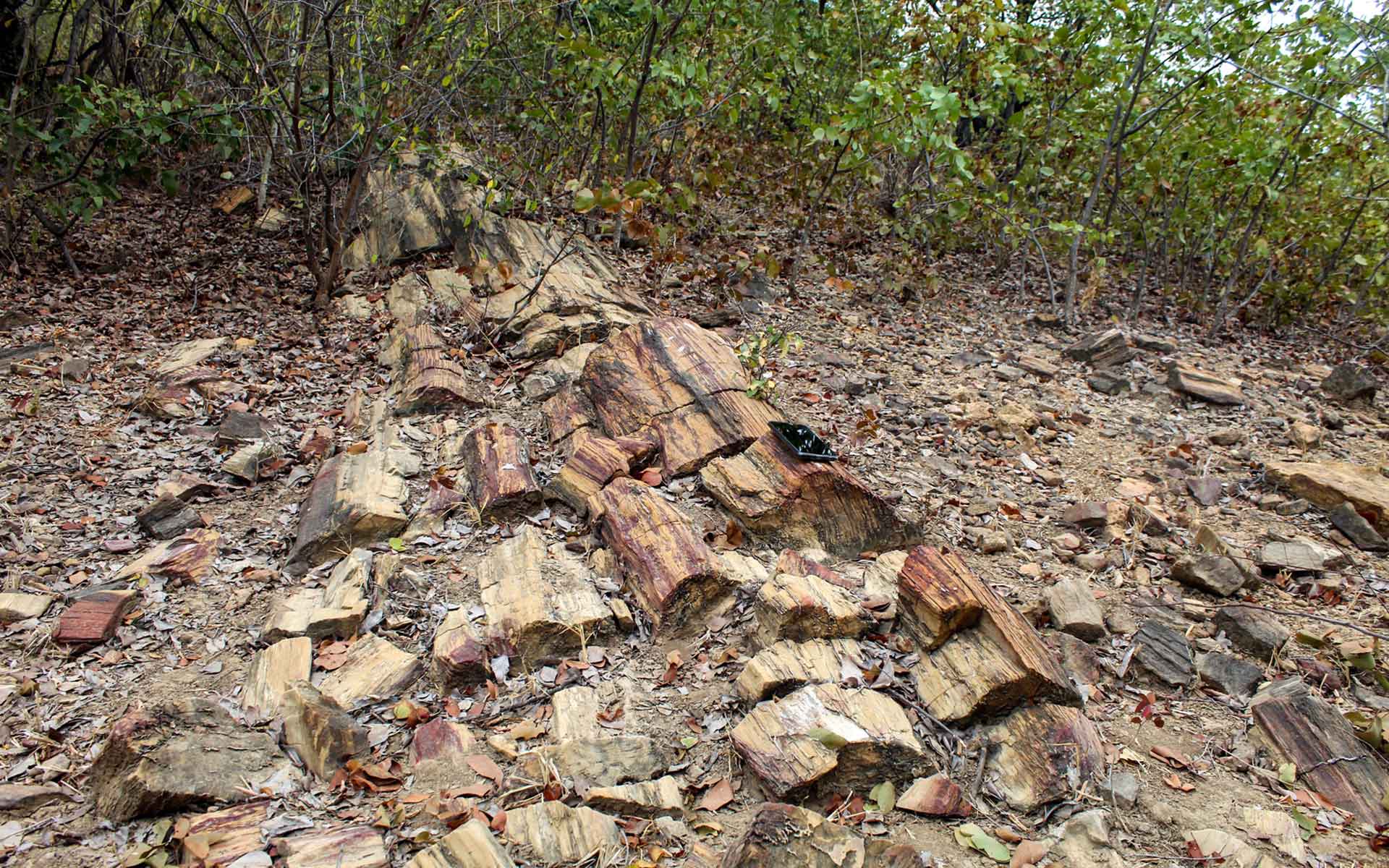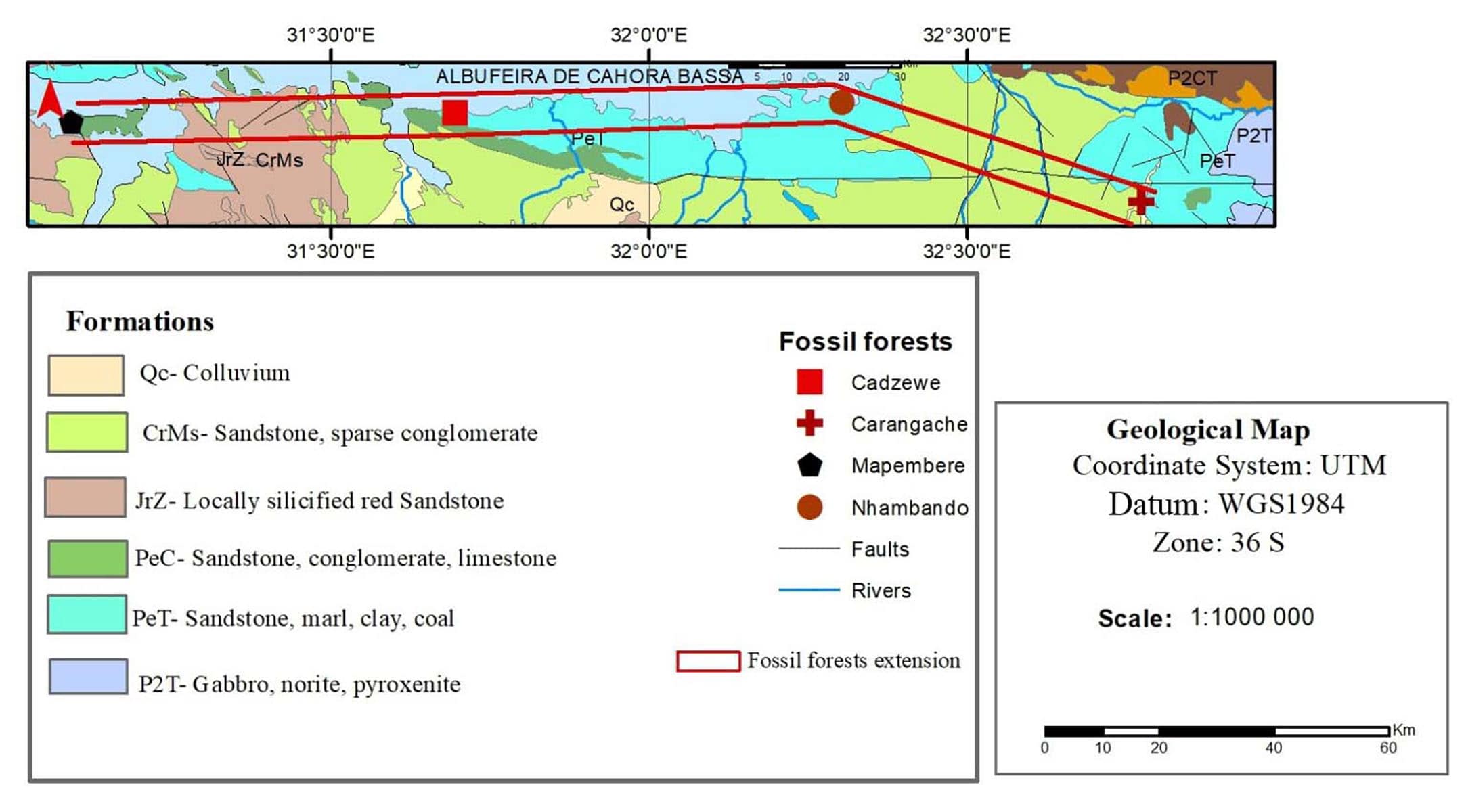
Petrified wood lying in the ground and some scattered trunks over the fossil forest from Nhambando site.
Geological Period
Late Permian
Main geological interest
Paleontology
Location
Tete Province, Mozambique.
15°43’31.0″S, 32°18’15.0″E
Petrified wood lying in the ground and some scattered trunks over the fossil forest from Nhambando site.
The most extensive largest fossil forest ever found in Africa.
The paleontological site extends over an area of 1482 km2. Fossil wood at Tete Fossil Forest is very well preserved, allowing the study of internal structures including tree fossil hollows (Araújo et al., 2018). Some woods already identified from TFF are Australoxylon teixeirae (new specie, Marguerier, 1973), Zalesskioxylon zambesiensis (new specie, Bajpai and Maheshwari, 1986), Agathoxylon Karoensis, Agathoxylon africanum, Cupressinoxlyon sp. nov (new specie) and Prototaxoxylon uniseriale (Nhamutole et al., 2021). These woods belonged to conifer trees that flourished in the area some 250 Ma (late Permian), representing a snapshot for the study of the flora of the worldwide Permian-Triassic Mass Extinction. In addition, this fossil wood has provided new scientific genera and species (Nhamutole et al., 2021).
- Geological description
The Tete Fossil Forest has a high density of petrified wood stems, both in situ and ex-situ, with the most remarkable trunk reaching 25 meters in length. Geologically, the Tete province is represented by the Vúzi and Moatize Formations, which are made up of glacial and fluvio-lacustrine deposits, tilites, carbonaceous schists, siltstones intercalated with coal beds. The overlying Late Permian to Early Triassic Formation is the Matinde Formation, which consists of cross-bedded sandstone, siltstones and coal beds. This formation contains large exposures of petrified woods within the terrains of the Karoo Vulcano-sedimentary Province. The exposures extend from the Carangache site to Mapembera locality, which represents a continuation of the same fossil forest (Nhamutole et al., 2021). In its turn, the Matinde Formation (Late Permian) which the Tete Fossil Forest is found is overlain by the following units in a stratigraphic order: the late Triassic Cadzi Formation, the Early Jurassic Zumbo Formation and other igneous formations.
- Scientific research and tradition
Many scientific papers have been published about the Tete fossil Forest, covering a wide range of topics. These include the systematic identification of plant types which have yielded important new wood species diversity, fossil leaves, external wood structures including tree hollows, and the need for preservation of this remarkable Late Palaeozoic flora. The list of publication are listed in the section for references, however some of the pioneering researchs in the area are from Silva et al., 1967; Marguerier, 1973; Bajpai and Maheshwari, 1986.
- Reference
Araújo, R. et al. (2018) ‘Fossil tree hollows from a late Permian Forest of the Matinde Formation (Tete, Mozambique)’. Available at: http://wiredspace.wits.ac.za/handle/10539/25916.
Bajpai, U. and Maheshwari, H.K. (1986) ‘Two new fossil woods from the Raniganj Formation with remarks on Zalesskioxylon zambesiensis from Mozambique’, The Palaeobotanist, 35(1), pp. 39–47.
Ferrara, M., Marques, J. and Costa, J. (2002) ‘Fossilized Forest in the Tete Province’, in. Florence, Italy.
Marguerier, J. (1973) ‘Paléoxylologie du Gondwana africain. Etude et affinities du genre Australoxylon’, Palaeontologia Africana, 16, pp. 37–58.
Nhamutole, N.E. (2021) Fossil woods from the permian and triassic of Mozambique: taxonomy, palaeocology and geoconservation. Thesis. Available at: http://wiredspace.wits.ac.za/handle/10539/32381.
Silva, G., Barreto, L. and Carvalho, L. (1967) ‘Palaeobotanical and petrographical study of a log of a petrified wood, identified as Dadoxylon nicoli Seward from the Karroo of Mágoè region, West of Tete’, Revista dos Estudos Gerais Universitários de Moçambique, p. 156.
- Author(s)
Nelson Ernesto Nhamutole
National Museum of Geology, Mozambique & Univesrity of the Witwatersrand, South Africa
Marcelino Moiana
National Museum of Geology, Mozambique
Dino Milisse
National Museum of Geology, Mozambique
Zanildo Macungo
National Museum of Geology, Mozambique
Ringo Benjamin
University Púnguè (UniPúnguè), Mozambique
University of the Witwatersrand, South Africa
Juana Vegas Salamanca
Geological Survey of Spain (IGME), Madrid, Spain
Enrique Díaz-Martínez
Geological Survey of Spain (IGME), Madrid, Spain


